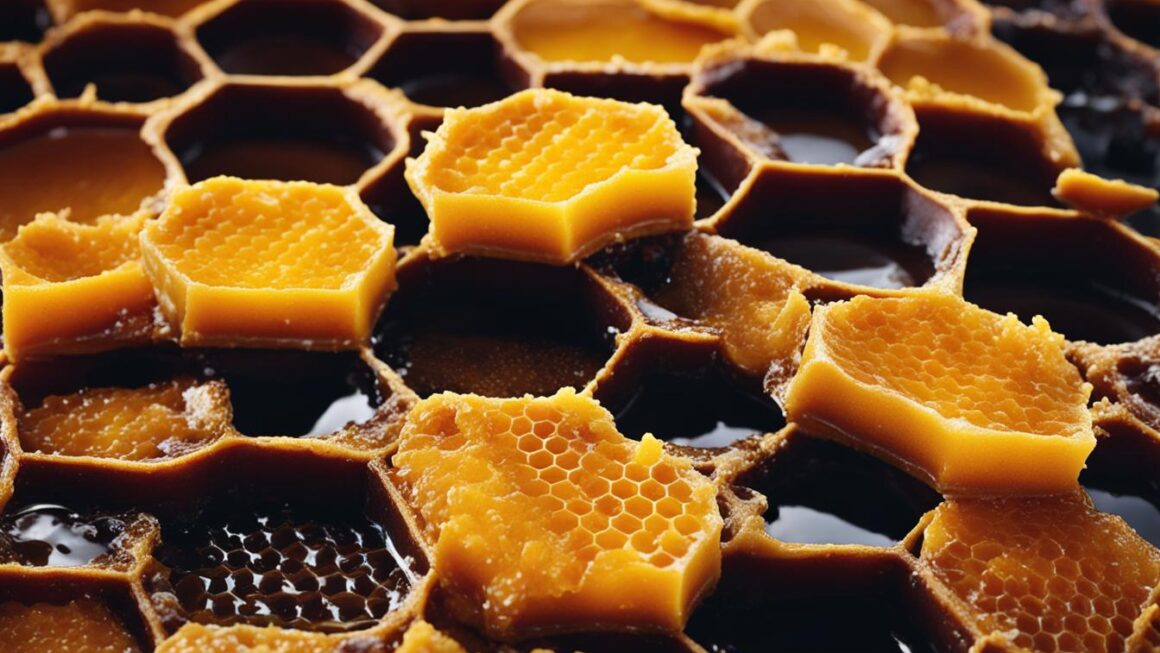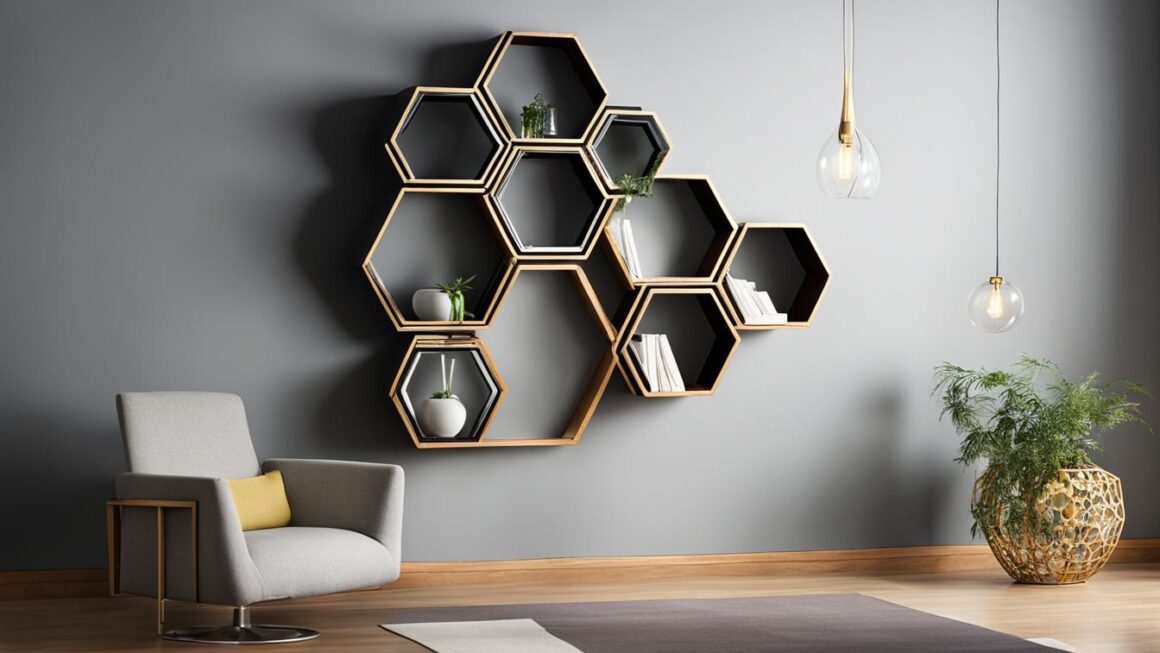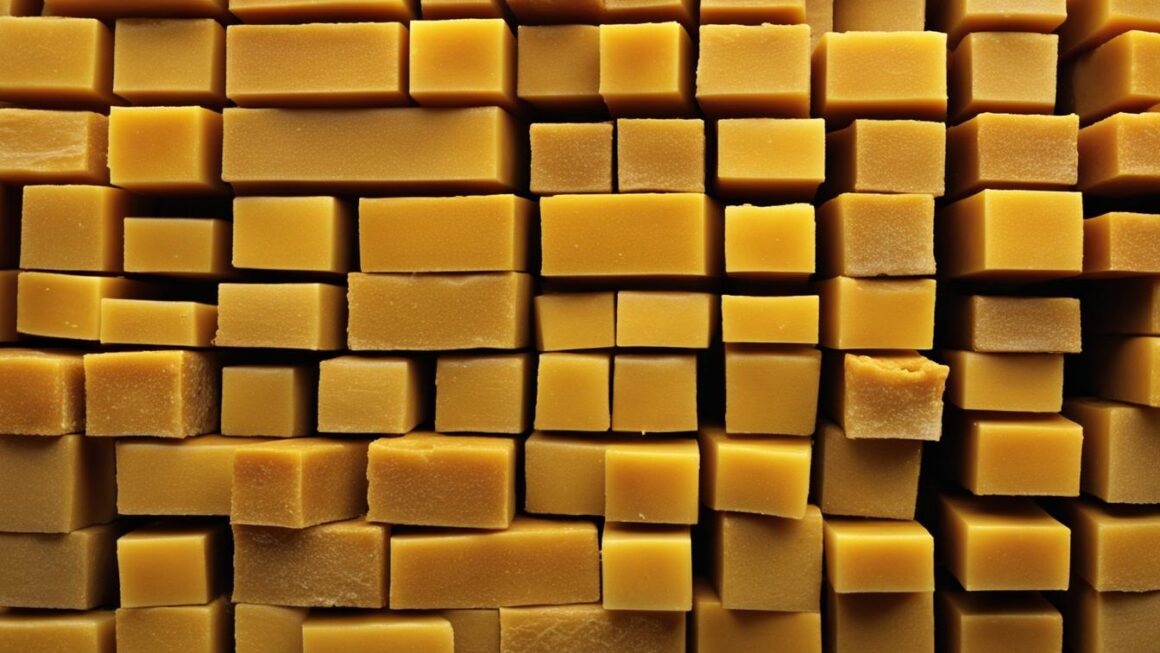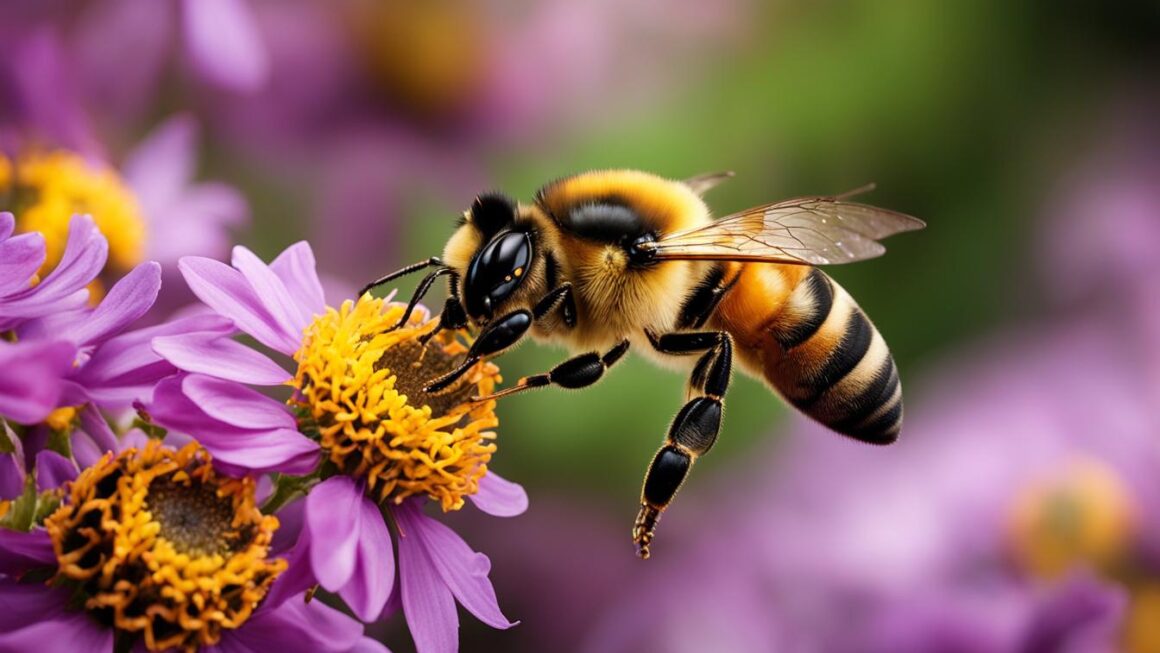Beeswax, a natural and versatile ingredient, has been treasured for centuries for its numerous benefits. Extracted from the honeycomb of bees, beeswax is non-toxic, hypoallergenic, and offers antibacterial and anti-inflammatory properties. This makes it a valuable resource in various industries such as cosmetics, food manufacturing, and woodworking. Additionally, beeswax holds spiritual significance in many cultures, believed to possess cleansing properties.
Key Takeaways:
- Honey beeswax is a natural and versatile ingredient with numerous benefits.
- Beeswax is non-toxic, hypoallergenic, and possesses antibacterial and anti-inflammatory properties.
- It finds applications in industries such as cosmetics, food manufacturing, and woodworking.
- Beeswax holds spiritual significance and is believed to have cleansing properties in many cultures.
Discover the Diversity of Beeswax Uses
Beeswax, a versatile natural ingredient, finds its way into a wide range of products and industries. Its uses extend beyond traditional applications, showcasing its adaptability and value. From candles to skincare, beeswax proves to be a valuable asset in many areas of our daily lives.
When it comes to candles, beeswax offers a natural and clean burning alternative. Its slow-burning properties and subtle honey aroma make it a popular choice among candle enthusiasts. Beeswax candles create a warm and cozy ambiance, perfect for relaxation and meditation.
Beeswax is also prized for its beneficial effects on skincare and cosmetics. Its moisturizing and protective qualities make it an ideal ingredient in lip balms, lotions, and creams. Beeswax forms a protective barrier on the skin, sealing in moisture and shielding it from harsh environmental elements.
| Product | Benefits |
|---|---|
| Beeswax Candles | – Natural and clean burning |
| Skincare Products | – Moisturizing and protective |
| Cosmetics | – Nourishing and soothing |
| Furniture Polish | – Enhances wood beauty and longevity |
In the realm of woodworking, beeswax is used to create furniture polishes that enhance the natural beauty and longevity of wood. It provides a protective layer that helps prevent drying, cracking, and fading while giving wooden surfaces a rich, lustrous shine.
Beeswax’s versatility truly shines as it finds its way into many aspects of our lives. Whether illuminating our homes, nourishing our skin, or beautifying our furniture, beeswax continues to prove its worth as a valuable and versatile ingredient.
The Remarkable Journey of Beeswax Production
Beeswax, a versatile and valuable substance, goes through a fascinating process of production within a beehive. Understanding how bees make beeswax and the intricacies of beeswax harvesting can deepen our appreciation for this natural ingredient.
Bees produce beeswax by secreting it from special glands on their abdomen. They shape the wax into pellets and store them in a chamber in the hive called the wax comb. This comb acts as the foundation for the beeswax production process.
The bees then process the initial pellets of wax by chewing on them and mixing them with saliva. This action generates heat, melting the wax and allowing the bees to mold it into flakes. The molten wax is then pressed together to create larger sheets or blocks of beeswax. To further fortify the comb, the bees seal it with a layer of propolis, a resin-like substance they collect from plants.
Harvesting beeswax from beehives is a delicate process that requires skill and care. Beekeepers have different methods for obtaining beeswax, such as removing frames of comb and scraping off the wax or melting down the comb to extract the wax. These methods ensure that the beeswax is collected in its purest form while minimizing disruption to the colony and the bees’ natural processes.
| Benefits of Beeswax Harvesting | Methods of Beeswax Harvesting |
|---|---|
| Ensures the availability of beeswax for various industries | Removing frames of comb and scraping off wax |
| Supports sustainable beekeeping practices | Melting down the comb |
| Provides beekeepers with a valuable byproduct |
Beeswax, a product of the remarkable journey undertaken by bees, has both ecological and economic significance. Its production and subsequent harvesting contribute to various industries and provide beekeepers with a valuable resource. Understanding the intricacies of how bees make beeswax and the careful process of beeswax harvesting enhances our admiration for this extraordinary natural substance.
Harvesting Beeswax: From Hive to Product
Harvesting beeswax is a crucial step in utilizing this versatile ingredient. There are different methods of collecting beeswax from beehives, each with its own advantages and considerations. One method involves removing frames of comb from the hive and scraping off the wax. This process allows beekeepers to collect beeswax without damaging the existing structure of the hive. Another method involves melting down the entire comb to extract the wax. While this method may result in the loss of the comb, it provides a more efficient way of obtaining a larger quantity of beeswax.
Once the beeswax has been harvested, it can be used to create a wide range of products. Beeswax candles are a popular choice, offering a natural and clean burning alternative to traditional paraffin candles. The beeswax can also be used to make furniture polish, providing a protective and nourishing treatment for wooden surfaces. In the beauty industry, beeswax is a key ingredient in skincare and cosmetic products, known for its moisturizing and healing properties.
| Beeswax Products | Description |
|---|---|
| Beeswax Candles | Natural and clean-burning candles |
| Beeswax Furniture Polish | Protective and nourishing treatment for wooden surfaces |
| Beeswax Skincare | Moisturizing and healing properties for beauty products |
Beeswax harvesting is an essential part of utilizing this versatile ingredient. The different methods of collection provide options for beekeepers to obtain beeswax without compromising the integrity of the hive. Harvested beeswax can be transformed into a variety of products, from candles to skincare and furniture polish, providing both aesthetic and functional benefits.
The Importance of Sustainable Practices
When harvesting beeswax, it is crucial to prioritize sustainable practices. Beekeepers should ensure that they leave enough wax in the hive to support the bees’ needs, including insulation and storage. This allows the bees to maintain a healthy and productive colony. Additionally, it is essential to use non-toxic methods when extracting beeswax to minimize any potential harm to the bees or the environment. By adopting sustainable practices, beekeepers can continue to enjoy the benefits of beeswax while preserving the well-being of the bees and the ecosystem.
Exploring the Uses and Benefits of Beeswax
Beeswax is a natural and versatile ingredient that offers numerous uses and benefits. Its unique properties make it a popular choice in various industries, ranging from cosmetics to woodworking. Let’s take a closer look at some of the key uses and benefits of beeswax.
1. Natural Lubricant
Beeswax can serve as a natural lubricant for various purposes. Whether you need to loosen a stuck zipper or lubricate a squeaky hinge, beeswax can provide a safe and effective solution. Its smooth texture allows for easy application, reducing friction and ensuring smooth operation.
2. Treatment for Cuts and Scrapes
Beeswax has long been used as a healing agent for minor cuts and scrapes. Its antibacterial properties help prevent infection, while its moisturizing effects contribute to the healing process. Applying a thin layer of beeswax to a clean wound can provide a protective barrier and promote faster recovery.
3. Key Ingredient in Candle Making
Beeswax candles are highly sought after for their natural beauty and clean-burning properties. Unlike paraffin candles, which release harmful toxins when burned, beeswax candles emit a natural, subtle scent and produce a warm, golden glow. The slow and even burn of beeswax candles makes them a preferred choice for many candle enthusiasts.
| Beeswax Benefits | Beeswax Uses |
|---|---|
| Natural lubricant | Cosmetics |
| Treatment for cuts and scrapes | Candles |
| Furniture polish | |
| Woodworking |
Beeswax’s unique benefits and diverse uses make it a valuable ingredient in various products and industries. Whether you’re looking for a natural lubricant, a healing agent, or a key component in candle making, beeswax can deliver the desired results in a safe and sustainable manner.
Next, we’ll delve deeper into the role of beeswax in the beauty industry, exploring its applications in skincare and cosmetics.
Beeswax in Beauty Products
Beeswax is widely used in beauty products due to its numerous beneficial properties. It serves as a natural moisturizer, protecting the skin from dehydration and environmental stressors. The emollient nature of beeswax helps lock in moisture, leaving the skin feeling soft and hydrated.
One of the key benefits of beeswax in skincare is its ability to create a protective barrier on the skin’s surface. This barrier helps shield the skin from harsh external elements, such as pollution and extreme weather conditions. It also aids in preventing moisture loss, making it an ideal ingredient for long-lasting hydration.
Beeswax is a common component in lip balms, moisturizers, and hair styling products. Its natural exfoliating properties make it suitable for facial masks and scrubs, helping to gently remove dead skin cells and reveal a smoother complexion. Additionally, beeswax provides structure and stability to natural soaps and body butters, making them more luxurious and long-lasting.
Benefits of Beeswax in Beauty Products:
- Moisturizing: Beeswax helps retain moisture and keeps the skin hydrated.
- Protective Barrier: It forms a protective layer on the skin, shielding it from external factors.
- Long-lasting Hydration: The emollient properties of beeswax help lock in moisture for extended periods.
- Natural Exfoliation: Beeswax aids in gentle exfoliation, removing dead skin cells for a smoother complexion.
- Nourishing: It provides nourishment to the skin, promoting a healthy and radiant appearance.
“Beeswax is a versatile ingredient in beauty products, offering moisturizing and protective properties to enhance the health and appearance of the skin.” – Beauty Expert
Table: Beeswax in Beauty Products
| Product Type | Benefits of Beeswax |
|---|---|
| Lip Balms | Provides hydration and protects lips from drying out. |
| Moisturizers | Locks in moisture and maintains skin hydration. |
| Hair Styling Products | Offers natural hold and moisturizes hair strands. |
| Facial Masks | Exfoliates gently and nourishes the skin. |
| Body Butters | Provides long-lasting hydration and nourishment for the body. |
With its multifunctional benefits, beeswax continues to be a popular choice in the beauty industry. Its natural properties make it a valuable ingredient in skincare, haircare, and body care products, offering nourishment, protection, and long-lasting moisture to enhance the overall health and appearance of the skin.

Beeswax in Home and Garden Care
Beeswax is a versatile natural substance that has been used for centuries in home and garden care. It offers numerous benefits and can be used in various ways to enhance the beauty and functionality of your living space. From furniture polish to wood preservatives, beeswax has a range of applications that make it a valuable tool for maintaining and protecting your home and garden.
Beeswax Furniture Polish
One of the most popular uses of beeswax in home care is as a furniture polish. Beeswax can be used to nourish, protect, and restore the natural beauty of wood furniture. It creates a protective barrier that helps to prevent scratches, water damage, and sun fading. By using a beeswax furniture polish, you can bring out the rich luster of your wooden furniture and keep it looking its best for years to come.
Beeswax Wood Preservative
In addition to furniture polish, beeswax can also be used as a wood preservative. Its natural waterproofing properties make it an excellent choice for protecting outdoor wooden structures such as decks, fences, and garden furniture. By applying a beeswax wood preservative, you can help to prevent moisture damage, rot, and insect infestation. It provides a durable and environmentally friendly solution for extending the life of your wooden surfaces.
Whether you’re looking to rejuvenate your furniture or protect your outdoor woodwork, beeswax offers a natural and effective solution. Its versatility and eco-friendly nature make it a popular choice for home and garden care. So why not harness the power of beeswax and give your living space the care it deserves?
| Beeswax Furniture Polish | Beeswax Wood Preservative |
|---|---|
| Restores natural beauty of wood furniture | Protects outdoor wooden structures |
| Prevents scratches, water damage, and sun fading | Prevents moisture damage, rot, and insect infestation |
| Nourishes and rejuvenates wooden surfaces | Creates a waterproof barrier |
| Environmentally friendly option | Extends the life of wooden surfaces |
Surprising Applications for Beeswax
Beeswax, with its natural properties and versatility, finds surprising applications beyond its traditional uses. From wood finishing to leather conditioning and even as an adhesive, beeswax proves to be a valuable ingredient in various industries. Let’s explore some of these unexpected uses:
Beeswax Wood Finish
Beeswax is an excellent alternative to chemical-based wood finishes. Its natural composition provides protection to wood surfaces while enhancing their appearance. The application of beeswax creates a smooth and durable finish, making it ideal for furniture, flooring, and other wooden items. It preserves the natural color and texture of the wood, giving it a warm and lustrous look.
Beeswax Leather Conditioner
Leather goods require proper care to maintain their quality and longevity. Beeswax serves as an effective conditioner for leather, keeping it soft, supple, and moisturized. When applied to leather products such as bags, shoes, or jackets, beeswax helps prevent drying, cracking, and flaking. It also creates a protective barrier against moisture and stains, extending the lifespan of the leather.
Beeswax Adhesive
Thanks to its sticky nature, beeswax can be used as a natural adhesive in various craft projects. Whether it’s assembling small wooden pieces or securing materials together, beeswax provides a strong and durable bond. Its non-toxic and eco-friendly properties make it a preferred choice for DIY enthusiasts and eco-conscious individuals.
With its surprising applications as a wood finish, leather conditioner, and adhesive, beeswax continues to demonstrate its versatility and usefulness. These unexpected uses showcase the diverse and sustainable potential of this natural ingredient. Its effectiveness and eco-friendly nature make it a valuable resource in various industries.

Beekeeping as a Lucrative Business Opportunity
Beekeeping has emerged as a lucrative business opportunity, capitalizing on the increasing demand for honey and related products. With multiple revenue streams, beekeeping offers a diverse range of opportunities for entrepreneurs looking to enter the industry. From honey production to beeswax products, pollination services, and even bee-related tours, beekeeping allows for the establishment of various income channels.
One of the advantages of starting a beekeeping business is the relatively low start-up costs compared to other agricultural ventures. The initial investment required for equipment and hives is significantly more affordable, making it accessible for small-scale operations or individuals looking for a side business. This accessibility combined with the growing demand for natural and organic products creates a favorable market for beekeepers.
Beekeeping Revenue Streams
When starting a beekeeping business, it is essential to explore the different revenue streams available:
- Honey Production: Harvesting and selling honey is one of the primary revenue streams for beekeepers. With the rising popularity of natural and sustainably sourced honey, there is a growing consumer demand for local and organic varieties.
- Beeswax Products: Beeswax can be used to create a wide range of products, including candles, skincare items, and even furniture polish. By utilizing beeswax in value-added products, beekeepers can maximize their revenue potential.
- Pollination Services: Beekeepers can offer their services to farmers in need of pollinators for their crops. This can be a mutually beneficial arrangement, providing an additional income source for beekeepers while supporting agricultural productivity.
- Bee-Related Tours: Sharing the fascinating world of bees with the public through educational tours and experiences can generate revenue and raise awareness about the importance of pollinators.
Success in the beekeeping business requires more than just managing the hives. Understanding bee behavior, seasonal patterns, and marketing skills are vital components for establishing a profitable venture. However, the rewards extend beyond financial gains. Beekeeping offers a unique opportunity to connect with nature, support pollinators, and make a positive impact on the environment.
Beekeeping as a Fulfilling Venture
Beekeeping offers a fulfilling and rewarding experience for individuals who are passionate about nature and the intricate workings of bee colonies. It goes beyond honey production and creates a unique connection between beekeepers and their bees. Through careful observation and management, beekeepers develop a deep understanding of the bees’ behavior, needs, and overall well-being.
By maintaining a healthy and thriving colony, beekeepers contribute to the pollination process, which is crucial for the growth and productivity of plants and crops. This symbiotic relationship between beekeepers and bees plays a vital role in supporting ecosystem health and preserving biodiversity.
Bonding with the Bees
Beekeeping allows individuals to form a special bond with their bees. As beekeepers care for their colonies, they witness firsthand the incredible work ethic and organization of these fascinating creatures. They observe the bees’ meticulous construction of honeycombs, their diligent collection of nectar and pollen, and their cooperative efforts to safeguard the queen and the entire hive.
Through regular hive inspections and beekeeping practices such as feeding, swarm prevention, and disease management, beekeepers become active participants in the lives of their bees. This close relationship fosters a sense of responsibility and stewardship, as beekeepers strive to provide a safe and nurturing environment for their colonies.
“Beekeeping offers a unique opportunity to immerse oneself in the wonders of nature and make a positive impact on the environment.” – John Smith, Experienced Beekeeper
Contributing to Ecosystem Health
Beekeeping is not only about honey and beeswax production; it is also a powerful way to support the health and well-being of pollinators. As bee populations face numerous challenges, including habitat loss, pesticide exposure, and climate change, beekeepers play a crucial role in preserving and protecting these essential pollinators.
By providing a safe haven for bees, beekeepers contribute to the pollination of local flora, ensuring the successful reproduction and growth of plants. This, in turn, supports biodiversity and the overall health of ecosystems. Additionally, beekeepers can educate their communities about the importance of bees and the role they play in food production and environmental sustainability.
Overall, beekeeping offers a fulfilling and hands-on experience that connects individuals to nature, fosters a deep appreciation for the intricate workings of bee colonies, and allows for meaningful contributions to the well-being of pollinators and the environment.
Conclusion
Beekeeping and the use of beeswax offer numerous benefits to individuals and the environment. The versatility of beeswax allows for its use in various industries, ranging from beauty products to home care and surprising applications. Beekeeping, on the other hand, presents a lucrative business opportunity with multiple revenue streams, such as honey production and beeswax products.
In addition to economic benefits, beekeeping allows individuals to connect with nature and make a positive impact by supporting pollinators. Beekeepers develop a deep understanding of bees, fostering a strong bond with their colonies. This unique relationship enables beekeepers to play a vital role in maintaining the health and productivity of the bees, contributing to ecosystem health.
Whether pursued as a hobby or a full-fledged business venture, beekeeping and the use of honey beeswax continue to demonstrate their value and importance. From their natural and non-toxic properties to their role in various industries, the benefits of honey beeswax are undeniable. So, whether you’re considering beekeeping as a business or simply looking to explore the uses of beeswax, the possibilities are endless.
FAQ
What are the benefits of beeswax?
Beeswax is naturally derived, non-toxic, hypoallergenic, and has antibacterial and anti-inflammatory properties. It is versatile and used in industries such as cosmetics, food manufacturing, and woodworking. Beeswax also holds spiritual significance in various cultures, believed to have cleansing properties.
How is beeswax used?
Beeswax can be used to make candles, skincare and cosmetic products, furniture polish, and wood preservatives. It is a natural moisturizer, protective barrier, and has healing properties for the skin. Beeswax is also used in home and garden care to polish wood, protect plants from frost, and clean windows.
How is beeswax produced?
Bees produce beeswax by secreting it from special glands on their abdomen. They shape the wax into pellets and store them in a chamber in the hive called the wax comb. The bees process the wax by chewing on the pellets, mixing them with saliva, and molding the molten wax into flakes.
How is beeswax harvested?
Beeswax can be harvested by removing frames of comb and scraping off the wax. Another method involves melting down the comb to extract the wax. Once collected, beeswax can be used to create a range of products such as candles, furniture polish, and cosmetics.
What are the uses and benefits of beeswax in beauty products?
Beeswax serves as a natural moisturizer, protecting the skin from dehydration and environmental stressors. It is found in lip balms, moisturizers, hair styling products, and even sunscreen. Beeswax also provides structure and stability to natural soaps and body butters.
How is beeswax used in home and garden care?
Beeswax can be used to polish and protect wood furniture, seal wooden surfaces to prevent moisture damage, and create a water-resistant barrier around plants to prevent frost damage. It is also effective in cleaning windows and creating streak-free shine on glass surfaces.
What are some surprising applications for beeswax?
Beeswax can be used as a wood finish, conditioner for leather goods, natural adhesive for crafts and projects, and it has insect-repelling properties.
How can beekeeping be a lucrative business?
Beekeeping offers multiple revenue streams, including honey production, beeswax products, pollination services, and bee-related tours. It requires relatively low start-up costs compared to other agricultural ventures, making it accessible for small-scale operations.
What are the benefits of beekeeping as a venture?
Beekeepers develop a deep understanding of bees and their needs, fostering a strong bond between them and their colonies. Beekeeping connects individuals to nature and provides a unique opportunity to contribute to ecosystem health by supporting pollinators.




